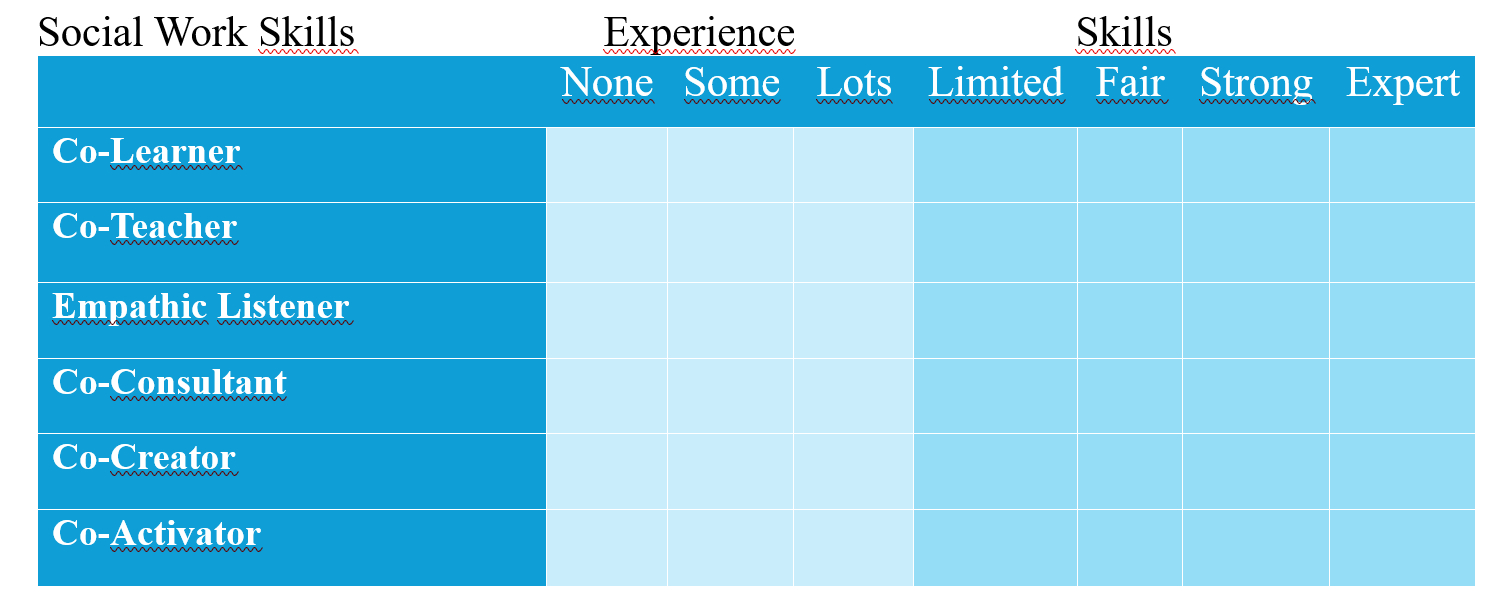2 Developing your Purpose

In this early stage of the process, your main task is to understand your own learning goals and consider how these goals may align with your internship agency’s context. This process involves personal reflection, exploration, and initial conversations with your internship supervisor. A common challenge at this stage is beginning the organizational assessment process – you may be new to the agency or working with a new supervisor; your status and relationships within the agency may still be tentative. These realities may cause discomfort as you work through this early stage; the guidance below – while unlikely to erase all discomfort – is intended to help you navigate the process with care.
Exploring your Learning Goals
 One of the Capstone course’s key intentions is to support your professional development goals. You likely have a vision for your career: experiences you hope to have and contributions you hope to make to the field and communities we serve. The Capstone project offers time and space to explore an area of growth related to your goals and future career. At this point, you may find it helpful to take stock of fundamental social work skills for integrated practice and assess your strengths and opportunities for improvement.
One of the Capstone course’s key intentions is to support your professional development goals. You likely have a vision for your career: experiences you hope to have and contributions you hope to make to the field and communities we serve. The Capstone project offers time and space to explore an area of growth related to your goals and future career. At this point, you may find it helpful to take stock of fundamental social work skills for integrated practice and assess your strengths and opportunities for improvement.
Consider completing the Inventory of Social Work Skills offered below; this short, reflective activity may just help you hone your priorities for the year.
Activity: Inventory of Social Work Skills
This activity is intended to help you identify some of your social work strengths and determine how you might want to use the Capstone experience to stretch yourself this year. Consider the social work practice skills listed below. Self-assess your current level of experience and skill development. Feel free to add additional skills relevant to your practice context that you may want to further develop. Use your rankings to identify 1-3 areas of growth.
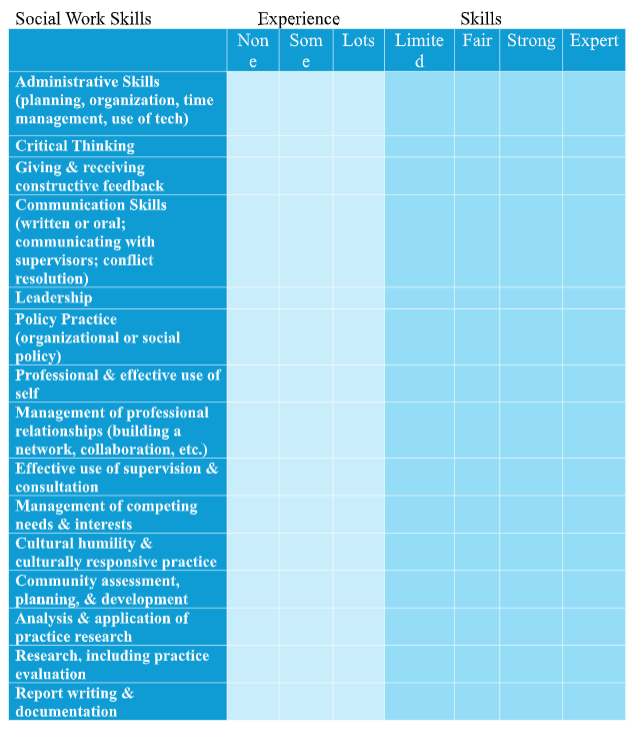
Reflections on Self-assessment
Take a few minutes to process your self-assessment. What stands out to you about your level of skill and experience? Does anything surprise you about this assessment? Does anything excite you within this assessment?
Priorities
Identify 1-3 areas of growth that you would like to prioritize in your final year of the MSW program.
1.
2.
3.
Practice Roles
Now consider social work practice roles. Which roles are you most confident in? Which would you like to prioritize in your final year of the MSW Program.
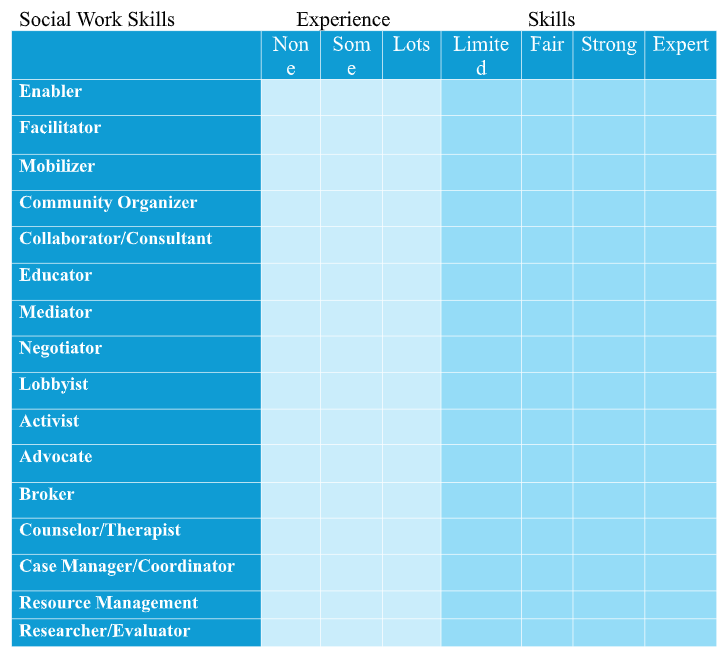
Preparation for anti-racist and anti-oppressive practice
As our profession further integrates anti-oppressive and anti-racist practices, new thoughts about the roles of social workers have begun to take shape. You will notice in the table below that these new conceptualizations focus on working within our competencies as a social worker in partnership with others. These new role conceptualizations emphasize how we co-produce knowledge and solutions with others. According to Payne (2014), by facilitating social change, social workers should seek mutual support and collaboration in society to help individuals who are disadvantaged to gain control over their own lives. Co-production can foster a more democratic culture by giving individuals equivalent rights and enhancing their access to opportunities in society. As an optional add on to the self-assessment, you can learn more about re-conceptualized roles and engage with the following reflection question. Based on your self-assessment, which re-conceptualized roles might you prioritize for growth & development this year?
05-Preparation-for-anti-racist-and-anti-oppressive-practice- (1)
Knowledge Acquisition
Also, consider reflecting on knowledge acquisition, including:
- Knowledge of specific practice settings (resources, DSM diagnosis, statutes, rules & procedures, funding streams)
- Knowledge related to advanced practice with various populations of persons or addressing various social issues
- Knowledge of specific social work theories & treatment modalities
Which areas of knowledge would benefit from further development? If you have identified multiple areas of knowledge, try ranking them in order of importance to your future practice.
Summative Reflection
Finally, consider your passions, values, and commitments.
- How might capstone connect with your passions, values, and commitments?
- Brainstorm potential agency-based opportunities that might align with the priorities you’ve identified above.
- Identify potential barriers or challenges to the various brainstormed ideas.
Mapping Social Work Skills to Capstone Projects
Now, take a look at table below, which maps social work practice skills to various project types and provides examples of how these various projects may align to micro-, mezzo-, and macro-level skills.

Now that you’ve taken time to assess your personal strengths, goals and areas of growth, it’s time to consider those of your organization. The section below will walk you through the basics of organizational assessment.
Assessing Organizational Needs (and Opportunities)
Deciding on a direction for your project can be incredibly challenging; after all, getting started is often the hardest part of anything new and unfamiliar. Taking the time to engage in an organizational assessment to determine the needs and opportunities within an organization can be a useful way to start.

To be clear, an organizational assessment is a systematic way to review multiple aspects of an organization to better understand its processes, services, skills, knowledge, and gaps. There are a variety of well-established assessment methods with differing theories and goals. Most often, though, these assessments call for a review of an organization’s strengths, areas for development and growth, opportunities and resources, and risks and threats.
Social work takes the role of assessment a step further. Coulshed and Orme (2012) posit that assessment is always ongoing and should focus on understanding the service user’s needs and using strategic frameworks for determining how to accomplish change. In other words, social work sees assessment as a process, not a singular event. Building on the knowledge of other organizational scholars (Coulshed & Orme, 2012; Milner & O’Byrne, 2009), Bolger and Walker (2018) developed key stages, characteristics and values, and guiding principles for implementing an organizational analysis aligned with social work values and perspectives.
The key stages of an organizational analysis include:
- Preparing for the task
- Collecting data from all involved
- Applying professional knowledge to analyze, understand, and interpret the information gathered
- Making judgments
- Deciding and/or recommending
The graphic below provides the characteristics or values that guide social work assessment. Each value should be considered and centered as you brainstorm and make decisions about your project direction.

Finally, Bolger & Walker (2018) outline Four Guiding Principles for Organizational Assessment.
- Understanding the Need. To practice this principle, a shared definition of need is provided. The authors posit that a need is defined as the issues and problems individuals experience that require a response, and there is an identifiable relationship between the issue and the response. In simpler terms, a need is a claim for service, an identified gap, and the resources to meet that need.
- Working with Systems & Ecology. The principle of working with systems is developed from Bronfenbrenner’s Ecological Systems Theory (1979), which states that all situations, problems, and behaviors are situated within the “layers of systems” that one encounters, from the family to the broader society and that all assessments should take account of these layers. The layers are defined by the ripple theory of interconnected systems levels (based in socialization theory) as:
-
- Micro-system: the family, school, workplace, etc.
- Meso-system: the interaction of two different micro systems.
- Exo-system: The community and / or external environment
- Macro-system: The socio-cultural environment
- Chronosystem: The dimension of time and how it relates to life events and the environment.
-
- Building on Strengths & Being Person-Centered. Building on Strengths as a principle is based on the premise of strengths-based theory, which identifies the importance of considering the capacities, strengths, and protective factors that also influence the issue or need. By exploring strengths, we honor and center the role of empowerment in resolving needs. A person-centered perspective takes the position that assessments should be developed with all stakeholders’ voices included and considered. Therefore, assessments should include the building of relationships and trust through intentional connection and engagement of the community.
- Taking an Interprofessional Approach. The interprofessional approach recognizes that different individuals bring different areas of knowledge and expertise to the table. Given these different experiences and perspectives, being able to bring those ideas in, organize them, and make sense of them is key. As cited in Bolger & Walker, “an effective interpersonal process that facilitates the achievement of goals cannot be reached when independent professionals work on their own” (Bronstein, 2004). It is important to highlight that this approach is not only about other professionals, but acknowledges the service user as the expert on their own experience and should also be included in an assessment process.
Important Note: please remember, it is NOT feasible to conduct a comprehensive organizational assessment during the planning phase of your Capstone project. In fact, doing so would be a project onto itself. Within the context of the Capstone course, we recommend:
- Start with your internship supervisor – make sure they are familiar with this course requirement and ask for their initial input into potential needs or projects; ask who else within the organization you should speak with to gain a more in-depth or nuanced perspective on possible needs and opportunities.
- Explore whether the organization has recently conducted a formal needs assessment; many agencies gather input from service users and community members. Perhaps there is an existing, identified need that remains unmet and aligns with your interests and goals. This can be a great starting point for a meaningful project.
- Use your foundational knowledge of how organizations function to observe strengths and areas of tension within the organization that might lend themselves to a quality improvement project.
- Which policies foster the organization’s success? Which hinder it?
- What resources are abundant within this agency? Which are scarce?
- How is power enacted within this organization? Whose voices are upheld? Whose are suppressed or excluded?
- Consider how decisions are made within this organization – how hierarchical is the organization? Who has the ability to approve of Capstone projects?
- Integrate an established assessment model, such as the SWOT / TOWS Analysis, SOAR, NOISE, or SCORE approach. See below for more information or check out the templates we’ve included for each model at the end of this chapter.
Tools for Organizational Assessment
Here you will find brief descriptions of four tools used for organizational assessment. We’ve included a link for each tool where you can find more in-depth information.
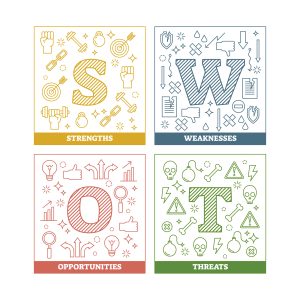
SWOT/TOWS Analysis
Strengths, Weaknesses, Opportunities, and Threats. While not technically a brainstorming tool, it can be helpful in assessing an organization or idea. The SWOT analysis begins with analyzing the internal process of an organization, the TOWS flips that and begins the analysis with considering the external opportunities and threats, which can help provide some boundaries around the internal assessment. Information on SWOT can be found here: Community Toolbox: SWOT Analysis
SOAR
Strengths, opportunities, aspirations, and results. This model integrates information about an organization’s present state with its members’ hopes and dreams to create an inspiring vision for the future from a strengths-based perspective and is closely aligned with the standard gap analysis. For more information, review the Partner for Better website: Understanding SOAR Analysis: Why Your Organization Needs One – Partner for Better
NOISE
Needs, opportunities, improvements, strengths, and exceptions. NOISE analysis is not simply focused on providing an analysis of the situation but also on potential solutions. A NOISE analysis is more collaborative and allows teams to work together. It allows an organization to analyze its current situation and formulate a strategic plan to improve it. It is a solution-focused analysis tool allowing teams to utilize their knowledge to achieve goals and solve problems. To read more about the NOISE Analysis, check out this link: The NOISE Analysis Model: A Strategic Alternative to SWOT Analysis | LinkedIn
SCORE
Strengths, challenges, options, responses, and effectiveness. Many people prefer SCORE’s “challenges” point because it combines threats, weaknesses, and obstacles into one area while enhancing their potential as opportunities. The SCORE technique also focuses on solutions by including the “responses” option. For more information, read the following: What is SCORE Analysis? Strategic Analysis Framework
Determining Potential Projects

You have explored your goals and begun to assess organizational needs and opportunities; now it’s time to brainstorm! There are likely a wide variety of ways to meet the goals and needs you’ve identified. So, how do you narrow in on a project that will be both feasible and meaningful to you and the community or agency you serve?
A good brainstorming session might be the answer you are looking for. While you’ve likely been part of a brainstorming process in the past, tools including Mind Mapping, Starbursting, 5 Whys, SWOT Analysis, and Concept Mapping may be handy at this stage of the process. These techniques are defined briefly below, with resources linked for each. You’ll also find templates for these tools at the end of this chapter.
Mind Mapping
A mind map is a visual diagram used to organize information around a central concept. The use of color & curved lines supports generative thinking. Check out What is a Mind Map? Definition, Uses, Benefits, & Examples | Creately for a more in-depth look. And with a quick internet search, you’ll find a wide variety of software programs to help you with this technique.
Starbursting
This technique addresses the who, what, where, when, why, and how of an idea. It is about generating questions pertinent to your idea. You can find a description of the process at: How to Run a Starbursting Exercise
5 Whys
This approach focuses on root cause analysis by asking a series of “why” questions. You can find a brief description of this process at 5 Whys: The Complete Guide with Steps, Templates, and Tips | Creately
Concept Mapping
Similar to mind mapping, this technique focuses on breaking down an overarching concept into smaller parts & identifying linkages between these parts. You’ll find a brief explanation and some examples at the Learning Center of UNC at Chapel Hill or the Learning Strategies Center at Cornell University. For a look at a more complex structure aimed at identifying a social issue check out Issue Mapping: A Social Science Perspective | Creately. Again, there are a variety of apps available, many of them free, to assist you with Concept Mapping.
Identifying the Social Impact

As you brainstorm projects ideas, you’ll want to begin considering their “social impact.” Social impact refers to the effect of policies, practices, and programs on society. The effects can be positive – fostering health and well-being for individuals and communities – or negative – causing harm to individuals and communities. Think of “social impact” as the consequences of our actions and inactions, particularly as they relate to issues of oppression and injustice.
In your Statement of Purpose, you will be asked to identify the broad, collective consequences of the social issue your project will address. Perhaps your issue presents challenges to public health, community safety, or economic stability, for example. You will also be asked to identify the potential positive impact of your project – what beneficial changes might your project bring about for individuals, communities, or the social service agency? Some examples of social benefits include racial and gender equity, increased accessibility of services, environmental sustainability, economic growth, and improved social cohesion, to name a few.
For now, as you think about social impact, consider the following questions:
- Who is impacted by this social issue? How are they impacted? How widespread is this social issue? How severe are the consequences if this issue persists?
- Who is likely to benefit from this Capstone project? How will they benefit?
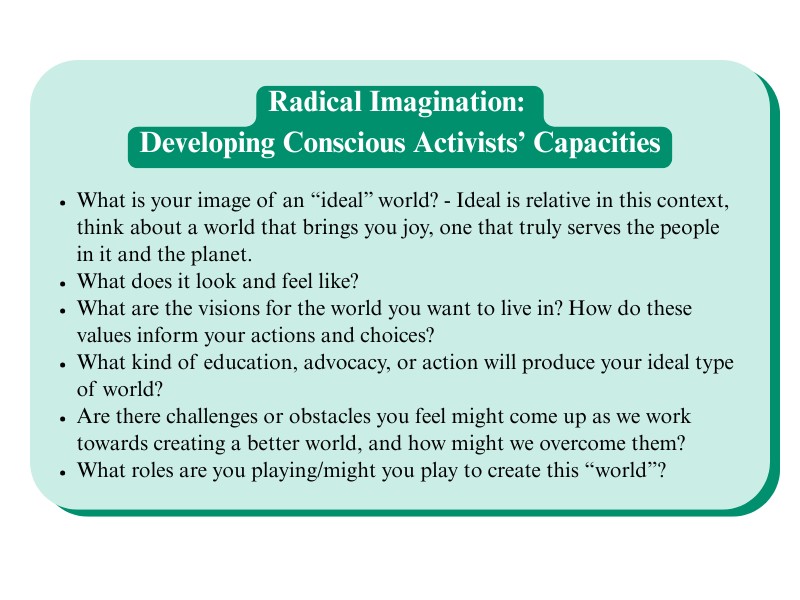
If you feel stuck, consider engaging your radical imagination (YouthxYouth, n.d.). Doing so may require you to slow down and make space for curiosity and experimentation. It may ask you to explore what is known and unknown. To play with possibilities.
The questions here, offered by YouthxYouth in the article Radical Imagination: Developing Conscious Activists’ Capacities, might help you envision what a world without this social issue would look and feel like. Alternatively, try out Rob Shorter and Rob Hopkins’ Imagination Sundial as a way of moving from “what is” to “what if.”
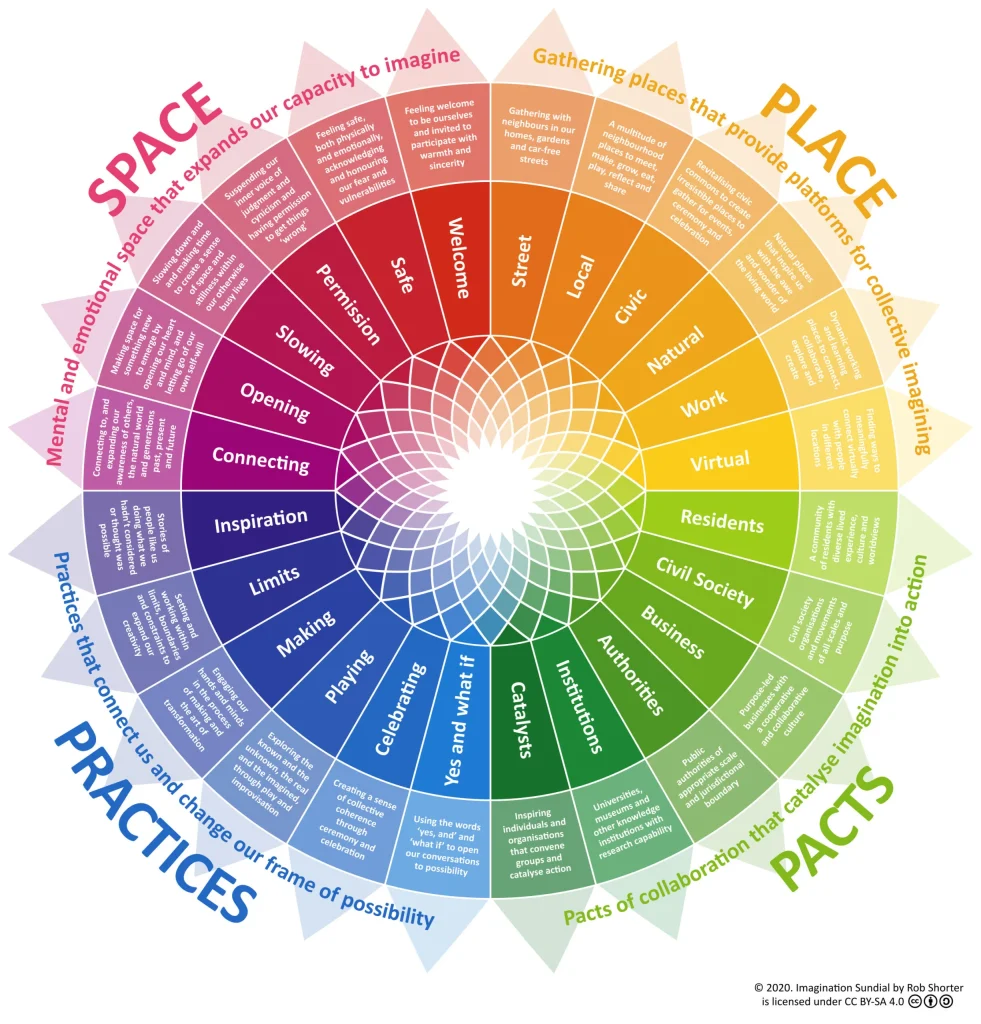
For more radical imagination exercises, visit The Commons Library: Radical Imagination to Expand Activists Capacities
The Everyday Activism Network provides an overview of the radical imagination concept.
Or check out Rob Shorter and Rob Hopkins’ explanation of the Imagination Sundial (seen above)
Connecting to Social Work Values & Ethics
Our obligation is always, as social workers, to be guided by our professional Code of Ethics (NASW, 2021). The values, principles, and standards set forth in this document provide guidance on appropriate behavior and ethical decision-making.
As your Capstone Project will be implemented independently, it is critical that during the planning phase you fully consider the ethical obligations and potential conflicts that might arise within your work. What core values are addressed through your project design? What ethical principles or standards might be significant to your work (privacy, confidentiality, informed consent, respect for autonomy, etc.)? What ethical dilemmas might arise? How will you navigate these dilemmas? When ethical issues arise, who will you turn to for support, feedback, and guidance?
This section of your Statement of Purpose should draw on the Code of Ethics to describe your commitment to adhere to professional ethics. Your critical thinking skills will be essential to this process, especially as you assess the potential risks, harms, and benefits of your project. For example, perhaps you are training elementary school personnel on incorporating trauma-informed principles into the school environment. While your training may align with all 6 of the core social work values, you’re particularly interested in fore-fronting how trauma-informed educational practices support both social justice and the dignity and worth of students, staff, and faculty alike. In this example, you would argue HOW this project challenges injustice and respects the dignity and worth of the school community. Later in the proposal you will also discuss the ethical issues or dilemmas that may arise within your project, and your intentions around how you will navigate these issues in accordance with our professional standards (more on this topic in the chapter Implementation Planning).
Drafting the Statement of Purpose
The statement of purpose is a clear, compelling, and succinct description of your Capstone Project’s goals, context, and impact. Within this statement, you will begin to present the case for your project and its importance for the internship agency, the field of social work, and broader society. The critical components of the statement of purpose are described below.
- An explanation of the broad social issue / phenomenon your project will address, such as mental health stigma among men or challenges of community re-integration post-incarceration. In this overview, you might draw on research and statistics to show the prevalence and severity of this social issue and its impact on individuals and communities. For example, you might highlight the rate at which male-identified people report stigma as a barrier to obtaining behavioral health treatment. You might also note the impact of untreated mental illness on individuals’ well-being, such as work absences, relationship struggles, or physical safety. Broad social consequences – economic impact, community disruption, homelessness, incarceration – should also be identified and discussed.
- A descriptive overview of the organizational context and how this social issue exists within it. Share the organization’s vision, mission, and service domain. Tell us about the people and communities served by this agency, as well as the programs and services offered. Then, describe the relevance of the identified social issue to this agency in particular. This is the organizational issue. For example, perhaps you are interning at a community-based mental health agency, and rates of engagement in services among men are lower than expected rates in the community. Or, at the re-entry program where you intern, the lack of social activities for clients acts as a barrier to rebuilding the community, a significant protective factor against recidivism.
- A discussion of the specific resource you plan to develop for the agency, focusing on HOW this resource will meet the identified need. This is the proposed Capstone Project. What potential impact will your project have on the organization and the people and communities it serves?
- An argument for the significance of your resource to the broader field of social work. How does this project reflect professional values and ethical principles? What contribution will this project make to social work? Draw on the National Association of Social Work (2021) Code of Ethics in your argument.
Resources for the Statement of Purpose:
A Word on Perfectionism, White Supremacy & Academic Socialization
Our academic socialization starts in our earliest schooling experiences and continues to shape our educational expectations throughout college. Many of our academic norms and systems are rooted in white, patriarchal, capitalist values, which are reproduced within us. While, at times, this socialization may foster our learning, it often hinders our creativity, authenticity, and agency. It may also reinforce oppressive cultural values such as perfectionism, one-dimensional thinking, relationships rooted in hierarchy, individualism, and comfort as a right.
This course asks us to challenge these norms and how we’ve internalized them over time. Take a moment to consider these questions offered by Dr. Perri Corvino:
- Are instructors understanding, flexible, compassionate, or dismissing, rigid, and cold? Can instructors be challenged? Does student voice matter? How do you feel when an instructor says that they don’t have the answer? How did these beliefs emerge?
- What does it mean if you miss class or if you turn in an assignment late? Why is a B an undesirable grade? What makes an A the only acceptable grade? What is your relationship to perfectionism? How did these beliefs emerge?
- Do you expect an instructor with privileged identities to tell you about the lived experience of marginalized people? Do you expect an instructor with oppressed identities to speak for the group? Do you expect to be able to lump together lived experiences based on one person’s narrative? Do you feel like you’re not getting your “money’s worth” if an instructor directs you to an external resource that was created by a marginalized voice?
Instead of falling back on our socialization, we can use this space to practice transformative cultural values and habits, as described by Debby Irving (n.d.). This course offers the opportunity to embrace:
- Collaboration, negotiation, and shared space
- Generosity (with our ideas, time, feedback, etc.)
- Multiple perspectives, multiple approaches
- Trusting our intuition as well as our intellect
- Curiosity and openness
- Humility and learning from our mistakes
In particular, the scaffolded nature of the Capstone Proposal assignment is a powerful chance to practice resistance to perfectionism. It can be uncomfortable to turn in draft assignments, ones that feel incomplete or don’t yet reflect our best work. We may feel vulnerable about the feedback we receive or the perceived judgment of others as our ideas – and articulation of them – continue to evolve. Resisting perfectionism requires us to embrace a new mindset. Remind yourself that your peers and instructor care about you and are committed to your growth; because we care about you as a person, we will show you kindness and compassion even as we offer critical feedback. Remind yourself that while turning in draft work feels uncomfortable, that discomfort will help you further develop your thinking and refine your project ideas. Finally, remind yourself that this is a complex, messy, non-linear process.
Chapter Summary & What’s up Next
We covered a lot of ground in Chapter 2, including:
- Exploring your personal strengths, goals, and areas of growth as a social worker.
- Assessing your organization’s needs, priorities, and opportunities.
- Brainstorming tools to help you determine potential projects
- Identifying the social impact of your capstone project
- Grounding your work in social work values and ethics
- Drafting your Capstone Proposal Statement of Purpose
In chapter 3, we focus in on how to explore theory and research relevant to your capstone project, as well as how to write your literature review.
